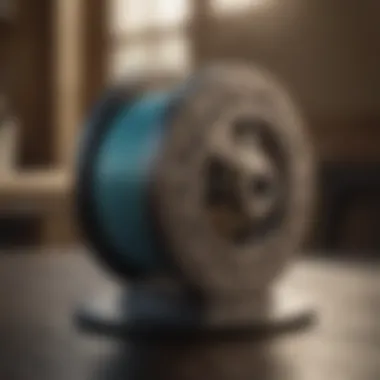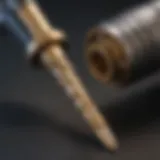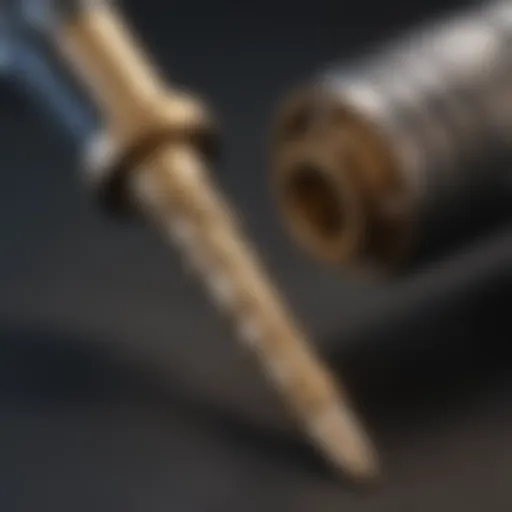Understanding Edger Spools: A Comprehensive Guide


Intro
Overview of Topic
Edger spools are essential components in gardening and landscaping, providing the cutting line needed to maintain neat and precise edges around pathways, flower beds, and lawns. These spools not only contribute to the aesthetics of a garden, but they also offer functionality that helps prevent grass and weeds from invading other areas. The design and material of an edger spool are crucial for effective trimming and cutting, making their understanding vital for homeowners looking to keep their outdoor spaces well-groomed.
Importance of the Topic
Edger spools represent a convergence of technology and practicality in home improvement. For homeowners and landscape enthusiasts, knowledge about these components extends beyond basic usage; it empowers them to select the right spool, maintain their equipment efficiently, and ultimately enhance their gardening experience. Given the rise of DIY culture, where homeowners take on landscape improvement projects, understanding edger spools is fundamental to achieving professional-looking results.
Common Challenges and Solutions
Common Issues Faced by Homeowners
Households often face specific challenges related to the maintenance and effectiveness of their edger spool. These challenges may include:
- Worn-out spools: Over time, spools can become degraded. This can lead to inferior cutting performance.
- Jamming: Cords can become tangled or jammed during use, causing frustrating interruptions.
- Incorrect installation: Improperly matched spools can affect the efficiency of the trimming.
Solutions and Tips to Overcome These Challenges
- Regular Maintenance: Inspect spools regularly for wear and replace as needed. Keeping an eye on the condition can save you time and hassle down the road.
- Proper Storage: Store spools in a cool, dry place to prevent deterioration of materials.
- Installation Guides: Follow the manufacturer's instructions for installation meticulously, ensuring compatibility with your trimmer.
“Understanding the nuances of edger spools can drastically reduce the number of headaches in the overall landscaping process.”
Product Recommendations
When considering edger spools, several noteworthy brands stand out due to their functionalities and advantages. Here is a closer look at some top products:
- Dewalt DWO1DT802: This product boasts an easy-load spool that reduces the hassle of line replacements. Additionally, it uses an extended line, delivering superior cutting capabilities. The design ensures durability.
- Ryobi AC14RL3A: Known for its affordability, this spool maintains performance without breaking the bank. It provides good length and easy reloading.
Benefits and Features of Recommended Products
Choosing the right spool can greatly impact performance:
- Ease of installation denotes user-friendliness in replacing spools.
- Durability relates to the product’s lifespan and cost-effectiveness.
- Compatibility with various trimmers extends functionality beyond single usage.
Step-by-Step Guides
To ensure optimal performance from your edger spool, consider these practical steps:
Practical Steps for Implementation
- Select the Right Spoool: Visit your local home improvement store or use vendor websites to find suitable spools.
- Remove the Old Spool: Disconnect your edger from power for safety. Remove the old spool according to the manufacturer’s guidelines.
- Load the New Spool: Insert the new spool into the holder, ensuring that the line feeds properly through the eyelets.
- Reassemble the Edger: After properly loading, reattach the hardware to secure everything. Like any project, double-check that all components are aligned and fastened in place.
- Test the Edger: Conduct a brief trial on garden edges. Check for any operational issues.
Detailed Instructions Where Necessary
For those new to edger maintenance, viewing a video tutorial or reading the manual can often clarify intricate steps. Tools for replacement may include basic screwdrivers and safety gear, as operating an edger can pose risks. Make caution paramount as you work.
Understanding the importance of these tasks can demystify the process and make home improvement more approachable.
Preface to Edger Spools
Edger spools play a crucial role in landscaping, especially for homeowners aiming to achieve well-defined edges. These tools are integral in maintaining the aesthetic appeal of gardens, driveways, and pathways. Understanding edger spools not only facilitates effective yard maintenance but also enhances one's ability to select and maintain the correct spool type for specific tasks.
Definition and Purpose
An edger spool is a component in manual or power edgers designed to hold the string that creates a precise edging in landscaping tasks. Its primary purpose is to store the string tightly and facilitate easy unwinding when in use. Without the edger spool’s efficient design, achieving clean and distinct lines around flower beds or driveways could be very challenging. The right spool brings efficiency, quality of cut, and ease of handling to any landscaping project.
Basic Functionality
The basic functionality of an edger spool revolves around its design and features. The spool houses a length of string, commonly made from nylon, which acts as the trimming tool when the edger is powered on. When pressure is applied to the ground, the string rotates at high speeds. As the string wears down or breaks, the spool allows for new string to be added or refreshed—some models will even feed out more string automatically when required. This immediacy allows for uninterrupted work, increasing efficiency in gardens maintenance tasks. It is essential to know how each spool operates to maximize your equipment's lifetime and maintain optimal cutting performance.
Key Takeaway: A good understanding of edger spools improves your landscaping effectiveness.
Components of Edger Spools
Understanding the components of edger spools is crucial for optimal functionality and maintenance. Each part plays an integral role in ensuring that your edger operates efficiently. Without a solid comprehension of these components, users may find themselves facing unnecessary frustrations.


String Material
The string material of an edger spool significantly affects its performance. There are different types of string materials, each offering unique advantages:
- Nylon: This is the most commonly used material due to its durability and resistance to breakage. It can handle tough cutting tasks effectively.
- Reinforced Nylon: For heavy-duty applications, reinforced nylon provides improved strength and longevity. It is ideal for tough grasses or weeds that are difficult to cut.
- Titanium: Some premium products feature a titanium core. This material can withstand extreme conditions and offers enhanced cutting capabilities.
Choosing the right string material is essential for achieving desired results and maximizing the life of the spool. Addressing the purpose and cutting needs will guide users in selecting the best string.
Spool Housing
The spool housing serves as the container for the string and plays a significant role in its functionality. A durable and well-designed spool housing ensures:
- Reliable performance: It holds the string in place while allowing for proper unwinding during operation.
- Ease of installation: A user-friendly design enables homeowners to replace spools with minimal effort.
- Protection of the internal elements: A robust spool housing safeguards the string and internal parts against dust and debris.
Generally, materials used in spool housing include plastic and metals. Both materials have pros and cons, primarily centering on weight, durability, and cost. Users should consider their needs in terms of longevity versus ease of handling when selecting an edger grewspool.
Spring Mechanism
A well-functioning spring mechanism is vital to the operation of an edger spool. Generally, the spring is responsible for the smooth feeding of the string while the edger is in use.
The spring mechanism allows the string to retract after cutting, preventing it from tangling or getting caught during use. This feedback ensures an efficient trimming experience. Without a functioning spring, users may experience:
- Constant string breakage
- Difficulty in cutting tasks
- Potential disruption and interruption in yard work procedures
Regular inspection and maintenance of the spring mechanism can significantly influence the lifespan and performance of the overall device.
Understanding these key components—string material, spool housing, and spring mechanism—empowers users in selection, maintenance, and troubleshooting efforts, ultimately promoting effective lawn care practices and prolonging growth cycles.
Types of Edger Spools
Understanding the various types of edger spools is pivotal in selecting the right one for specific landscaping needs. Each kind is designed with unique capabilities suited for diverse tasks. Knowing these distinctions helps users make informed choices that enhance efficiency and stretch the lifespan of their tools. Moreover, discussions about functionality, durability, and suitability reverberate throughout this guide.
Fixed Spools
Fixed spools are one of the simplest types available. They come preloaded with string material, which stays contained until worn down. These spools are optimal for routine edging tasks that do not require frequent string adjustments.
- Advantages: They are relatively easy to replace, often requiring minimal tools. This can saves time and is beneficial for homeowners looking for straightforward maintenance.
- Disadvantages: Their capacity is limited, and they may not perform as well in challenging terrains with thick vegetation.
When considering a fixed spool, reflect on how often you plan to use it. For small gardens, a fixed spool can suffice, preventing over-complication.
Automatic Spools
Automatic spools, also known as self-feeding spools, offer a higher level of convenience. As the string wears down, these spools automatically extend more string, an advantage for extended trimming sessions. This feature reduces interruptions, allowing the user to maintain a flowing rhythm while working.
- Mechanism: The mechanism is engineered to keep the working string length consistent, a critical factor in achieving clean edges.
- Considerations: Users must ensure that their edger is designed for automatic systems. Also, some skills in handling the device may be needed, as misalignment can hinder functioning.
These spools can be particularly appealing for anyone who engages in heavy landscaping tasks.
Heavy-Duty Spools
Heavy-duty spools are built with robustness at the forefront. They typically utilize advanced materials designed for use on rugged terrains. Professional landscapers and avid gardeners prefer these spools due to their longevity and performance under challenging conditions.
- Durability: The string materials in heavy-duty spools often withstand wear-and-tear better than standard options.
- Best Use Cases: Ideal for larger yards or jobs that involve dense, thick brush. Homeowners around tall grass, valuable shrubbery, or uneven grounds can greatly benefit from choosing a heavy-duty model.
Selecting the Right Edger Spool
Selecting the appropriate edger spool is key to achieving an efficient gardening performance. The right choice affects not only the quality of the cuts on your landscape but also the ease of use. Considering factors such as the type of landscaping involved, user experience, and compatibility with your edger model ensures optimal results.
Factors to Consider
When choosing an edger spool, several critical factors come into play. These factors include string type, spool compatibility, and the specific requirements of your gardening tasks.
- String Diameter: Wider strings tend to last longer and handle tougher weeds, while finer strings provide more precise cutting but wear out quickly.
- Spool Compatibility: Not all spools fit every edger. Checking compatibility ensures an effortless installation process.
- Material Used: The durability of the string material affects overall performance. Nylon is most common, but some spools may feature durable composite materials for extended use.
- Weight and Balance: A heavier spool may add stability, but can also increase the exertion needed during use. Choosing one that balances weight will make handling easier.
- Weather Resistance: Exposure to moisture and dirt can degrade spool quality. Options with weather-resistant materials enhance their longevity.
Compatibility with Edgers
Understanding compatibility is vital so that one can avoid frustrations during the replacement process. Edger spools are designed to function with specific models and brands really well. Here are some points regarding compatibility:
- Brand Specificity: Some brands produce spools uniquely for their machines, like Husqvarna, Makita or Black & Decker. Check the label on your device before selecting a spool.
- Model Variability: Even within the same manufacturer, models may have different spool requirements. Always refer to the model number for precise information.
- Line Thickness Compatibility: Make sure that the line thickness of the spool works with the edger. Line dimensions can greatly impact performance.
- Multipurpose Options: Some spools are advertised as compatible with multiple brands. However, reviewing user feedback is critical to support claims of broad compatibility.


Renowned brands provide detailed schematics or charts that delineate compatibility among their spools and edgers. Personally reviewing this information saves time and transforms the landscaping experience into more black-and-white.
By seriously considering these elements, you empower yourself to select the right edger spool, leading to an improved overall gardening tasks.
Installation Process of Edger Spools
Installing a new edger spool correctly is crucial for achieving optimal gardening results. The installation process can greatly impact the functionality and longevity of the spool. A well-installed spool ensures that the string feeds properly and operates efficiently, reducing the chances of malfunction during use. Understanding this process not only saves time but also ensures productive landscaping without unnecessary hassle. It involves understanding several core steps, which can make the entire gardening experience smoother and more enjoyable.
Preparation
Before starting the installation of an edger spool, several preparatory steps must be followed. Proper preparation prevents complications that may arise during the installation. Ensuring all tools needed are within reach creates an organized workspace, allowing for a straightforward installation.
Key Preparatory Steps:
- Read the User Manual: It is important to review the instructions specific to your edger model. This will provide insights on compatibility and unique requirements for the spool.
- Wear Safety Gear: Wearing gloves and eye protection can help avoid injuries caused by debris or unexpected spool launch during installation.
- Gather Tools: Common tools might include a pair of scissors, a screwdriver, or a wrench, depending on the edger model.
- Prepare the Work Area: Ensure a clean and adequately lit area for installation. Removing obstacles reduces the risk of injuries or errors.
Step-by-Step Installation Guide
The installation process breaks down into clear and easy-to-follow steps. These guidelines will serve as a roadmap for effectively replacing your edger spool.
- Disconnect the Edger from Power: Ensure the tool is unplugged or the battery is removed before beginning to avoid any injuries.
- Remove the Old Spool: Open the housing of the edger. This may involve unscrewing or simply pressing to release the spool. Carefully lift out the old spool and inspect the housing for any debris or damage.
- Insert the New Edger Spool: Take your new spool and align it with the housing. Spools often come with marked guide slots, helping place it correctly. Place it carefully to avoid bending any parts.
- Thread the String Through the Eyelets: With the spool mounted, take the string and thread it through the eyelet. Pull enough length through to use effectively during operation.
- Wind the String Properly: Wind the string onto the spool, securing it by aligning it with the housing guides. Make sure it's evenly distributed to avoid tangling during use.
- Secure the Spool Housing: Replace the housing cover and ensure it locks into place. Wipe away any dust or particles that collected during installation.
- Reconnect Power and Test the Tool: Plug in or reattach the battery and power it on to check functionality. Observe if the string feeds smoothly when the device is operated.
Important: Always consult your user manual at any step if confusion arises. Application of these steps will lead to enhanced efficiency in your gardening tasks as they promote a longer life for your edger spools and effective trimming duties.
Following these steps creates a systematic approach to your installations, reducing malfunction costs and ensuring your landscaping obligations are met efficiently.
Maintenance of Edger Spools
Maintaining edger spools is vital for prolonging the life of the gardening equipment and ensuring optimal performance. Regular maintenance not only enhances the functionality but also ensures that every gardening task is completed with precision. Edger spools are exposed to various elements that can affect their condition over time; therefore, understanding effective maintenance practices will save time and enhance efficiency while working in the garden.
Regular maintenance saves time, prevents costly replacements, and ensures optimal performance of your edger spool.
Cleaning Techniques
Cleaning edger spools is a fundamental step in maintenance. When grass clippings, dirt, or debris accumulate, they can lead to spool jamming or inefficient cutting. To clean an edger spool:
- Disconnect the edger: Always ensure the appliance is unplugged or the battery is removed before cleaning to avoid accidents.
- Use a soft brush: A soft brush or cloth can remove most clippings and debris without damaging the spool. It's important to get into the small crevices where dirt can trap.
- Inspect the string: Check for frays or broken strands during cleaning. Replace any worn-out sections to avoid future issues.
- Rinse if Necessary: For tougher residue, rinse the spool under water, ensuring it is thoroughly dried afterward before reassembly.
These steps help maintain a clean operatin environment, allowing for a good manage of the edger spool effectively.
Preventive Maintenance
Preventive maintenance can avoid bigger problems later on. Regular checks can save the user from pricey repairs or replacements. Here are consider significant preventive maitenance practices:
- Check spindle and bearings: Ensure that spindle rotates smoothly and bearings are lubricated where necessary. This can reduce wear over time.
- Store Properly: Store your edger spool in a dry place to prevent exposure to moisture, which can cause rust on certain components.
- Inspect before each use: Taking a moment at the start of each task to examine the spool will allow early detection of potential issues.
- Replace the string periodically: Instead of waiting for string failure, replace the string based on usage frequency, ensuring you always have the best performance.
By implementing these preventive measures, you can ensure longevity and optimal functionality of your edger spools, making your gardening tasks more manageable and efficient.
Common Issues with Edger Spools
Identifying common issues associated with edger spools is essential for proper maintenance and efficient usage. By understanding these problems, homeowners can ensure longer life for their gardening tools while also optimizing their landscaping tasks. Common issues may lead to poor performance or damage to the tool, affecting the overall quality of your landscaping.
String Breakage
String breakage is a frequent issue that users encounter with edger spools. This can be caused by several factors, including:
- Poor quality string material: The durability and resilience of the string directly affect its longevity. Materials like nylon or polyester tend to be more durable but may vary in quality.
- Inappropriate string gauge: Using incorrect thickness might lead to unnecessary breaks, especially under heavy usage.
- Obstructions: Cutting through thick grass, branches, or stones can quickly dull or fray the string, leading to eventual breakage.
To mitigate string breakage, consider the following practices:
- Always use high-quality string materials recommended for your specific edger model.
- Adjust the spool settings to ensure proper tension while working.
- Clear the area of debris and reduce contact with hard surfaces. Regular maintenance will optimize the string's life and keep your edger working effectively.
Spool Jamming
Spool jamming is another crucial concern with edger spools that affects performance significantly. Jamming can arise due to several reasons such as:
- Incorrect installation: If the spool is not installed properly, the string may not dispense correctly, leading to tangles.
- Worn-out components: Over time, spool components can wear out, causing alignment issues that trigger jamming.
- String entanglement: Improper wound string can also cause the spool to jam.


To resolve and prevent jamming, keep these strategies in mind:
- Follow installation guidelines meticulously to ensure the proper setup of the spool.
- Regularly inspect and replace worn-out components to avert performance issues in the future.
- Always wind the string evenly on the spool to avoid entanglements. Proactively addressing these common problems promotes a smoother experience with your edger and an improved lawn care routine.
"Proper knowledge about common issues can significantly enhance your experience and efficiency with edger spools."
Innovations in Edger Spool Technology
Innovations have become key in the domain of edger spools. The landscape maintenance industry has undergone many changes lately, thanks to advancements in technology. These innovations enhance efficiency, effectiveness, and sustainability in gardening. Adoptions of smarter technologies and eco-friendly materials are essential developments happening today.
Smart Edger Spools
Smart edger spools represent a significant leap towards modern landscaping tools. These spools incorporate electronic features. For example, they provide user insights via integrated sensors. These sensors can monitor the status of the spool's string. They can also alert the user about string levels, which prevents unexpected interruptions during the use. Traditional spools do not offer this level of knowledge.
Moreover, a few models come equipped with smartphone connectivity. Homeowners can receive updates and warnings positioned right on their devices. This will allow them to manage their lawn care efficiently, with minimal hassle. These features not only save time but also improve user experience. It may even simplify tasks for users who have less experience in operating these tools.
Sustainability Considerations
Sustainability considerations are crucial in every industry today, and edger spool technology is no exception. Many manufacturers focus on using recyclable materials in spool construction. This reduces overall waste and offers an environmentally friendly path in gardening. Edger spools made of high-density polyethylene are common as they can endure wear while being more sustainable compared to conventional materials.
Additionally, biodegradable string options are beginning to emerge. These options decompose over time, making them more suitable for eco-conscious users. Selecting sustainable products benefits the environment and contributes to greener practices frequently being pursued by homeowners.
Nevertheless, consumers should carefully evaluate the lifespan as they seek sustainable options. They must ask if pursuing eco-friendly products leads to more durable solutions. It's essential that these items do not compromise performance to meet eco-friendly standards.
A focus on sustainability and smart technology invites a positive transformation in landscape care for modern homeowners.
Through the interplay of technological innovation and sustainability, the edger spool market is evolving. The advancements not only refine the user experience but also promote more conscientious environmental stewardship.
Environmental Impact of Edger Spools
The subject of the environmental impact of edger spools is becoming increasingly relevant. Landscape maintenance involves more than just trimming grass; it affects the ecosystem in various ways. Sustainable practices in gardening tools, particularly edger spools, must be considered as the focus on environmental consciousness grows.
Understanding eco-friendly edger spools can help optimize not only gardening but also the environmental footprint associated with these tools. Several factors contribute to their ecological impact: material sourcing, recycling options, and disposal strategies. Every aspect plays a role in promoting a greener world.
"The true challenge lies in combining functionality of our tools with the need to protect our planet."
Material Sourcing
When examining the sourcing of materials for edger spools, it is vital to consider the environmental consequences of production steps. Many edger spools use plastic for their construction. The origins of this plastic can greatly influence their ecological impact. Spools created from recycled materials such as PET (Polyethylene Terephthalate) contribute positively towards reducing waste in landfills. Manufacturers who emphasize sustainable sourcing can mitigate pollution and lessen resource depletion.
Several materials commonly found in edger spools are:
- Nylon: Known for its durability, varies in its production practices.
- Plastic composites: Created from a combination of materials, often including recycled components.
- Bio-based plastics: Offer sustainable alternatives with a lower carbon footprint.
Practicing responsible sourcing is crucial for manufacturers and consumers to align with greener practices. Familiarity with the suppliers and the types of materials utilized can lead to informed purchasing decisions.
End-of-Life Disposal
End-of-life disposal of edger spools is an often overlooked but necessary component of their environmental impact. Once the spool has reached the end of its usable life, it is essential to consider how to manage its disposal. Responsible disposal means diverting waste from landfills and reducing environmental stress on ecosystems.
Key aspects of effective disposal include:
- Recycling: Many components of edger spools can be recycled. Identifying local recycling programs can facilitate this process. Before disposal, check if the spool material is accepted for recycling.
- Waste diversion: Compostable materials may result in less pressing waste disposal issue; consider gradual disposal approaches.
- Manufacturer return programs: Some manufacturers implement incentive programs for returning old tools, enabling proper recycling and responsible disposal.
Educational resources regarding recycling practices and disposal guidelines can help users make better choices. Understanding these alternatives aligns with a broader goal of enhancing environmental sustainability. By prioritizing responsible disposal, leafy green spaces become less hazardous and healthier for community aesthetics and ecology.
Culmination
Edger spools play an integral role in maintaining both the aesthetics and functionality of outdoor spaces. The conclusion of this guide encapsulates the main insights regarding edger spools, emphasizing their significance for both the novice gardener and seasoned landscaper. Understanding edger spools is essential for preserving garden features and ensuring smooth lawn management processes.
In this article, we discussed the components, types, and maintenance procedures critical for enhancing the longevity and performance of edger spools. Paying attention to factors such as string material and installation methods has long-lasting implications on the overall effectiveness of garden edging techniques.
Summary of Key Points
- Functions: Edger spools are vital for precision trimming and establishing clean edges between grass and garden beds.
- Variety: Different types of spools cater to various gardening needs, from fixed options to automatic ones that simplify usage.
- Maintenance: Regular cleaning and preventive practices can significantly improve the lifespan of edger spools, making them a cost-effective component of gardening equipment.
- Environmental Impact: A shift towards smart spool technologies is enhancing sustainability in this field, helping to minimize waste.
Understanding these facets allows homeowners to choose the right products that blend efficiency with environmental prudence.
Future Outlook
The landscape of gardening tools is evolving, with innovation being a key factor in product development. As technology shape consumer preferences, the market for edger spools is likely to experience substantial transformation. Future designs may focus on enhanced durability, increased ease of use, and environmentally friendly materials that lessen ecological footprints.
Speculative advancements include integrated smart technologies that provide real-time feedback for optimal usage. Such innovations can streamline gardening processes, promote safety, and ensure better performance under various conditions. As otomating trends encome into practice, the adoption of intelligent edger spools will likely drive homeowners toward more efficient maintenance experiences, potentially shifting perceptions of effective garden care.
Keeping these trends in mind can empower housewives and homeowners, allowing them to remain a step ahead as they curate their landscapes.







